As we all know we are not immune to the nature’s disasters. There are certain at-risk zones in the world where some specific disasters occur. For example, tsunamis on the East coast of Japan and tornadoes in North America (mostly in the United States). In this article we’ll focus on how to teach your children about the possibilities of a tornado, how to prepare for it, what to do to increase the chances of survival and minimize risks.
[the_ad_placement id=”in-text-1-type-r”]We encourage you to spend a lot of time talking, preparing, practicing and sharing experience with your kids. This helps them understand such possible situations much better. Don’t turn these lessons to lectures, as the kids will surely get bored and not listen to you. Instead, make it fun but also point out that it is nonetheless a serious matter. As long as you practice together and you show genuine interest yourself, children are going to copy your behavior.
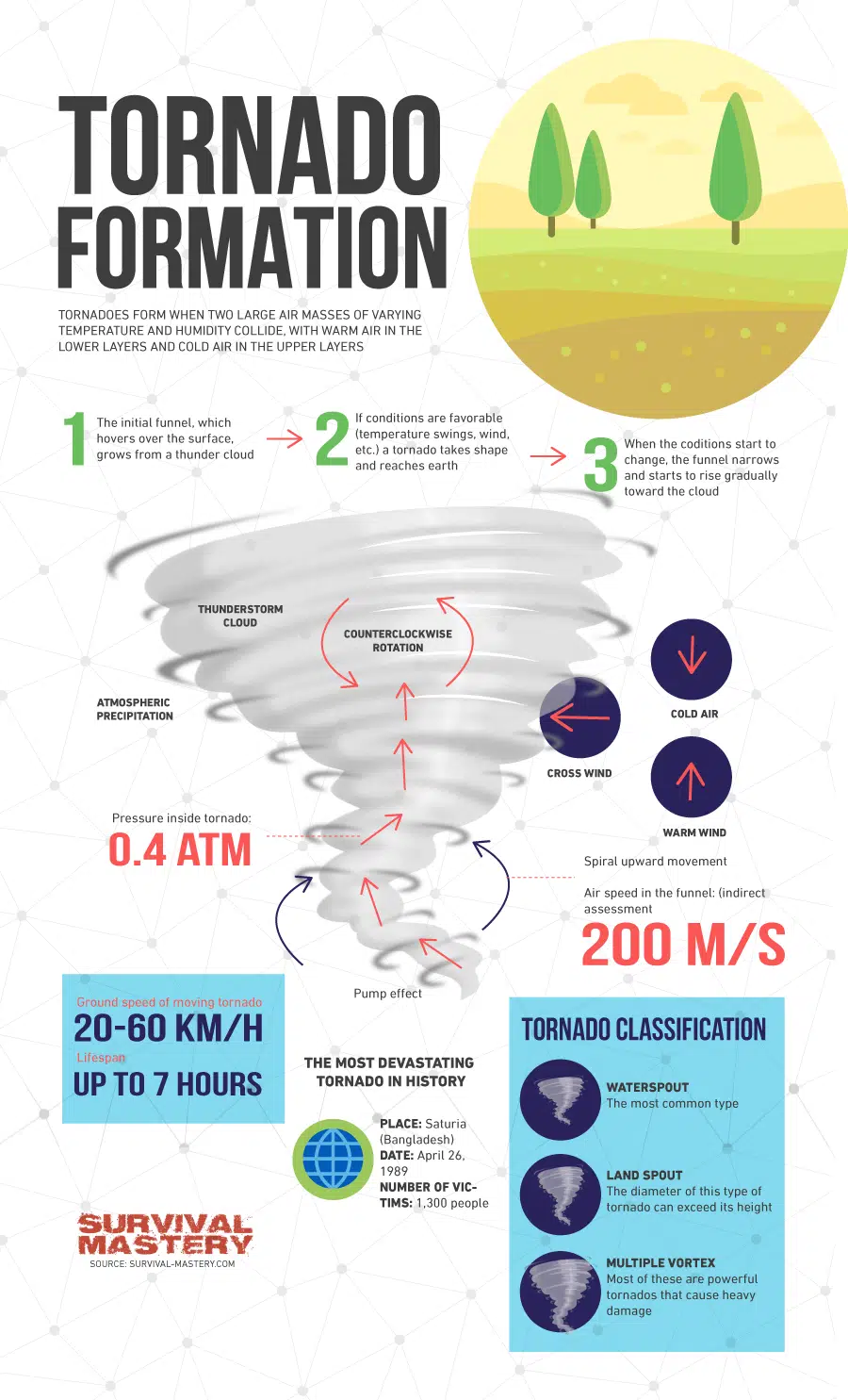
In this article we’ll help you and give your ideas on what to talk about, how to prepare the kids and how to practice together.
Be ready – preparation stage
At first you may wonder how to talk with your children about disastrous events. It is very easy to cross the line and actually frighten your kids too much. Yet it is as easy to keep your talk too ‘childish’. There is a risk that your kid will misunderstand you and these valuable lessons will have been in vain (and be forgotten when you’re finished).
First of all you need to talk about safety tips in general. Explain to your child to look up at the sky regularly, especially in a cloudy hot day. If there are specific clouds and cloud gatherings at one place, if there is rotation at the base of the cloud and lowering of the cloud towards the ground, flashes around the cloud, etc. your kid must immediately evacuate. At best, this would mean to leave the open ground and head for a strong sturdy building nearby.
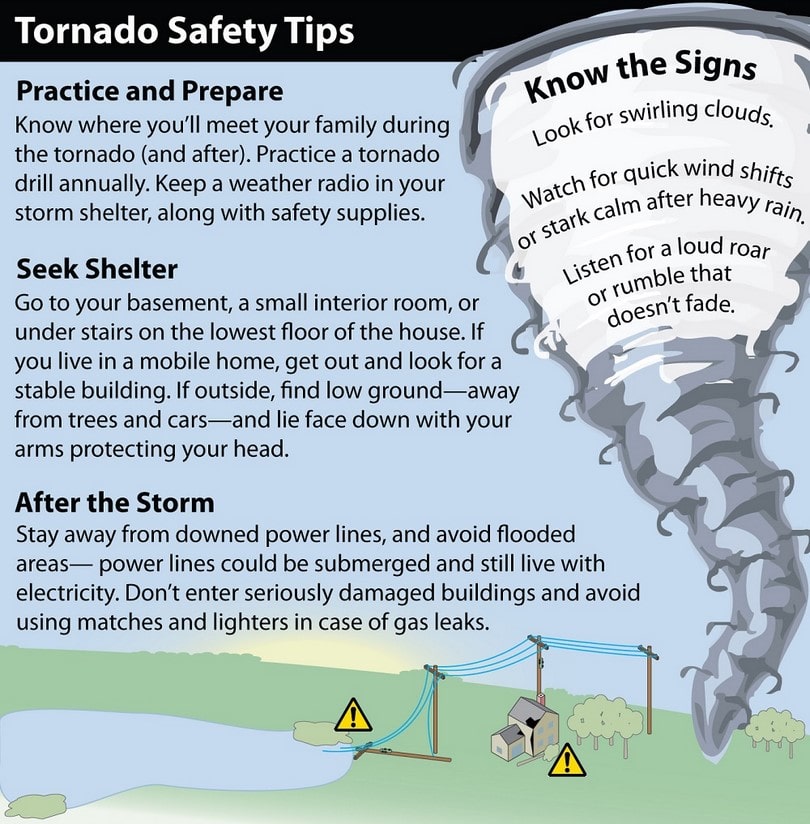
Also, talk about what other signs to look for. Usually tornadoes form after strong storms. There may be hail before it and rain afterwards. Also, the air before a tornado forms is heavy, moist and hard to breathe. It’s hot and humid outside. In addition to visuals, tornado’s are very noisy, and sound like very loud trains. If you don’t know much about how to describe a tornado, you can read about the preceding signs.
Also, explain to your child how a tornado forms and why. Tell them that the cold air that accumulates above the hot air needs to fall down (as cold air is heavier than hot air). This is the reason why people see a funnel forming – the cold air tries to ‘escape’ through the thick warm air (which rises above). These details may seem pointless to know, but it gives an idea of what to look for and which signs nature presents us, so we can prepare better.
Also, make them realize that a tornado may entrance them, as it is an incredible sight. People often are captivated by the sight of a tornado and waste precious time for evacuation. For children it may be even more interesting, but they have to understand that there’s no time to enjoy the sight.
Also, your child must know that after a tornado she/he must not go under bridges, near electrical lines, damaged building (risk of collapsing), etc. Tell them that if they see dangling cables anywhere around them, they must never approach them. Also, let them recognize the smell of flammable gases. It is very often the case that gas bottles are damaged and gas escapes. If there are damaged cables nearby, this combination may cause explosions. Teach your kid what to do in such situations. Let them know that they have to leave the area immediately and seek safer ground.
Along with explaining all these details, gather your family and develop your own safety plan. Involve your kids in all your plans so that they know all the details. Make sure they participate with ideas and show genuine interest in your preparation. If this is not the case, your kid may miss important points and details. Find a way to increase their interest so they are more actively involved. We have a great article on how to be prepared for a natural disaster that you can adapt for children.
We also advise you to get to know your kids’ school safety plans. It is understandable if you rush at the school to be with your kids, but if there’s an emergency situation, you may be in far greater danger on your way to the school. Teachers are well prepared and trained for such events and kids are safe with them. It will be a good idea to know how well kids are prepared, and if there are drills at school and how children are instructed as to what to so in case of a tornado. If they haven’t done any such drills, propose this to the school principal (or headmaster).
If you know that kids are trained at school and are aware of the risks (and know how to handle such events) this will give you a peace of mind. Get to the when the tornado is gone.
[the_ad_placement id=”in-text-2-type-r”]Another valuable safety tip is to teach your kids about emergency phone numbers and instruct them to always keep their cell or smart phones close at hand in case they have to make an urgent call. Stationary phone lines are usually damaged after a tornado so a mobile phone may save your kid, if it knows whom to call and how to ask for immediate help.
Another useful thing to do together is to prepare a disaster safety kit – you can read more about this in our best survival kit article. Involve all family members and do this together. Let everyone know what is in the kit, how and when to use the items. Prepare a manual and let them know about it. Everyone should be aware of it and know how to use it.
Prepare also a supplies kit for your car as well. You may happen to be in the car when you see the tornado developing. Decide together where you will keep the disaster kits. They must be accessible for every one of your family. Teach your kids how to use bandages and perform first aid – it is useful for both them and/or their friends.
Knowledge and practice = saved life
It is very important (as we already mentioned above) to practice a lot. All of the above may be just too theoretical, but when the actual disaster hits, people tend to panic and run here and there frantically. So, talk with your kids and spouse what each step is from the moment you hear the sirens or see the tornado.
Practice drills and set time limits. Observe how quick everyone is, what everyone decides to take along, etc. Talk to your kids about the most important things to take. They won’t have to handle the documents and ID’s (which is a grown-up’s business), but will have to take some warm clothes. Talk and discuss the most important possessions that must be saved. Otherwise, make your kid understand that saving his/her toys is a waste of valuable time, when it’s a matter of life and death.

Image credit: wuky.org
It may also be a good idea to surprise your family with improvised sirens and see how everyone reacts, and what everyone is doing, saving, etc. Observe their actions and analyze it together afterwards. The idea is not to scare them intentionally, but to see their (usually subconscious) reactions.
Optionally, you may warn them that at random you will use sirens to practice an imaginary tornado disaster. In this way they will know you plan this, but will not know when it will happen. And remember, this is not a joke, so don’t abuse this or next time they hear a real siren, they will not believe it and will think it’s yet another joke.
Talk to your kids about how to use a weather radio. For many reasons, during a tornado, TV connections, Internet, etc. will get lost. Weather radios on the other hand can still work and be used to get constant updates on the situation outside. It’s a good idea to buy a small portable weather radio for each of your children and instruct them to carry the radios every time they leave home or are alone. Teach them how to use the radio and practice together. If you involve the radio in casual games, they will begin to like it and will in fact prefer to use it in other situations. For this, check out great list of the best 7 weather radios on the market.
Talk about the weather alerts and how to recognize when a situation is critical and when not. Discuss the warning and watch alerts and what each one means, including what to do if you hear it on the news. The kids should know that a watch alert is that there is some potential for tornado in the area (or nearby areas). People are advised to prepare to evacuate to safe places, prepare their safety kits and listen for updates. A warning is when you need to act immediately.
Take only the most valuable possessions and hide to your safe place. Instruct your children about these alerts and practice what they have to do in each one. Tell them to listen to NOAA’s radio channel and let them know how to tune to it quickly. Optionally, listen to the local radio channel.
Another important thing to talk to your children is that they should not attempt to reach you, if they are away from home (and you at work). If they are at school, with their friend’s parents, etc. they should stay with them until it’s safe outside. As long as your kids are with an adult, they are much safer, than trying to get to you. Teach them that in emergency situations they must never run away alone or stay alone. It can be extremely dangerous for them to just leave school as the tornado hits the town.
In case of warnings, sirens or radio alerts, take immediate action. Even if the situation is not life threatening, you need to show example on what to do as a warning is issued. Children copy the adults’ actions and with time they will get used to taking the appropriate actions wherever they are – at school, at a friend’s house, at home alone or with you. In any case, they will be trained and prepared. Also, teach them to always put a helmet whenever they can in case of an issued warning. It’s a good practice to keep a helmet close at hand.
Also teach your kids what to do if they are alone or away from home. They must be prepared to act immediately no matter where they are. Explain to them that they have to stay inside a strong sturdy building (or wherever they are at the moment a warning is issued or the tornado is spotted). They have to stay as far away from windows as possible, as glass can shatter and hurt them badly.
Staying between walls (corners) can be a safe place. Tell them to find a low spot, floor, where to go hide. It is a good idea to find blankets or pillows (even mattresses) to cover themselves. The trick though is that they should not waste too much time in doing so, since they may expose themselves to further danger. If they can’t grab a pillow within a minute, then it’s better to just hide in the safest spot in the building.
If your kids are outside, they should immediately go to the closest building. If there are no buildings nearby, they must find a low spot on the ground and lay there. They must put their hands on their heads and necks to protect them.
It is important that you teach your children how to stay calm. It may be very easy to say, since even adults hardly can do it. Nonetheless, you can practice breathing techniques together. You may also have to teach yourself to stay calm in dangerous situations. Children sense their parents’ fears and they panic even more as a result. So, to avoid that, try not to show your fear as much as you can. Talk calmly. It’s a good idea to sing songs during a critical situation.
Whenever a disaster occurs, sing songs together and stay calm. The human brain can’t think properly in critical situations. So, avoiding panic is actually the first step to clear thoughts during a disaster.
Safety tips for your kids on “after tornado” stage
Preparation for and during a tornado is as important as knowing what to do afterwards. People were usually shocked and stressed when they realized what had happened. As a tornado went down on your town it will leave destruction and debris after its wake.
You have to instruct your children beforehand that they should not attempt to reach you afterwards. Let them know that wherever they are, they are safe there and that you’ll get to them as quickly as you can. Make them trust you that you’ll be on your way to them and you will eventually reunite as soon as you can. Use your cell (smart) phones to keep an ongoing connection and let each other know that you’re alright.
[the_ad_placement id=”in-text-3-type-r”]You should also reassure them that even if it’s not you who reach them first, there is going to be rescue teams within minutes after the tornado had hit your town. They will be saved quickly after it’s gone. Knowing this can give them some peace of mind and in this way they will be less frightened.
As a result their actions will be far more coordinated and reasonable. Of course, in case they got trapped in the debris or fallen walls they must know that they have to scream loud in order to be heard by the rescue party. Even if they are injured they should attempt to talk or shout loudly. However, the human voice (especially the one of a child) can be muffled by debris and other sounds in the area. That’s why you should consider giving them an emergency whistle, like the Vargo Titanium emergency whistle. This one comes with a cord and is light enough to wear wherever the kid goes. More on whistles and how to choose them in our article on best emergency whistles.
If you were together during the tornado, then you would probably be together after the event too. In this case, involve your children in the aftermath activities, cleaning the rubble, etc. On the other hand, let them stay safe in case you decide to look for people under the rubble of fallen buildings, walls, etc. Let your children know that damaged buildings, electric poles (and other electrical devices) are extremely dangerous and they should stay away from them.
Experiencing a tornado can be really hard for children. They may be afraid of it for life. It is your task as their parent to prepare them, practice with them and talk about it before and after it. These things will make it much easier for children to tackle the stress and fear. This will also help them avoid panic attacks in the future whenever they encounter another tornado or another natural disaster.
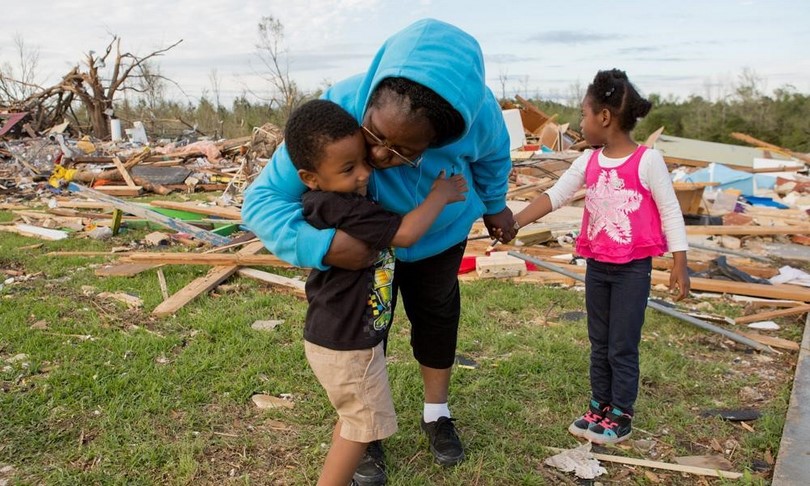
And after all one of the best things you can do for your kids in the case of tornado is talk about it. Whenever you hear on the news of a tornado that hit some town, listen carefully. Both the news report and what the affected citizens of the town say can be equally valuable. It is the experiences of other people that can help your kid get an idea of the situation. Also, talk about how your kid feels, before and after. Talking through the emotion a tornado causes, can relieve the stress and can be a bonding experience.
As long as your kids are aware of the dangers and of their own emotions then the crisis will be handled much easier. A good and strict preparation beforehand combined with drills can be the ultimate safety tip for both you and your children.



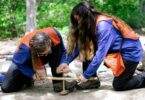

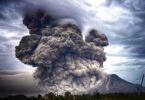
Most kids are intelligent when it comes to survival. If I had kids, I’d teach them using some interactive methods, enroll them in courses, and do everything in my power to let them learn about safety and surviving a tornado.
Hi Corey,
Young kids have exceptionally retentive memories but you would have to analyze their psychological profiles to see if they are ready to be taught survival techniques. Some might just see them as “play” and might do random stuff that can be harmful to them.
Thanks!
Samuel
Great article, and yes, I agree kids are incredibly intuitive when it comes to survival.
I always pack extra toys in our basement during tornado season to make them feel comfortable too.
Putting bike helmets on their heads is a great idea, as well as bringing some sort of an air horn which will help announce our presence in case of a disaster.
Apart from packing toys and other items for your kids, gather your family and develop your own safety plan. Involve your kids in all your plans so that they know all the details.